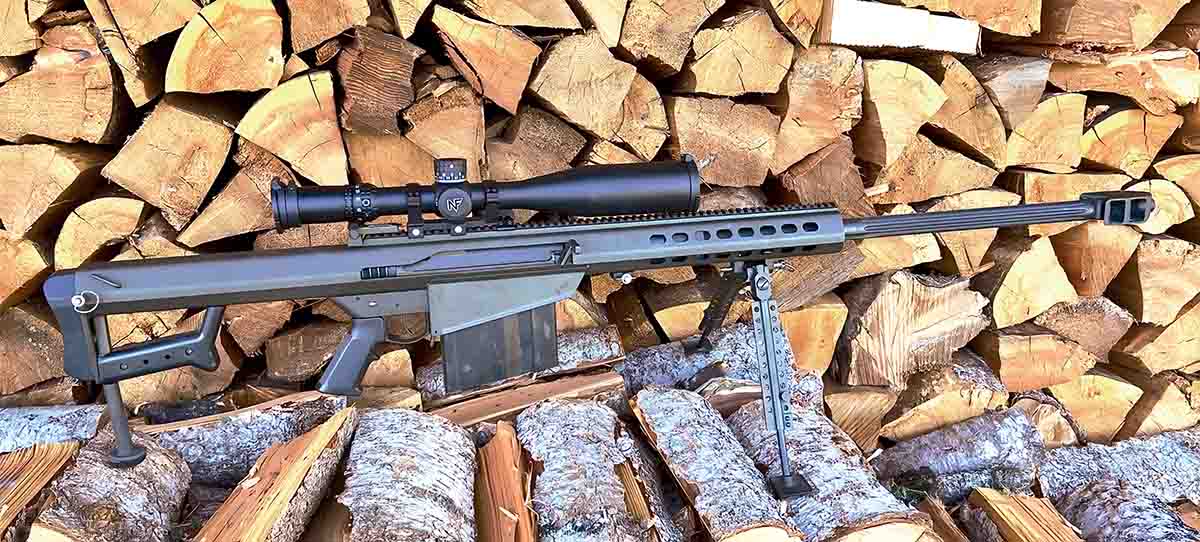
A Barrett M107A1 was used to test the .50 BMG. This was an early military-grade, all steel version of the company’s recoil-operated semiautomatic rifle. Barrett was one of the very first to offer a shoulder-fire .50 BMG rifle for civilian use.
The .50 BMG – or 12.7x99mm in NATO terms – is our largest commercially-available sporting cartridge. Just to put things into perspective, an entire loaded .223 Remington 55-grain full metal jacket round would easily fit inside a hollowed .50-caliber, 750-grain bullet. The .50 BMG (Browning Machine Gun) propels a 750-grain bullet with a ballistic coefficient (BC) of 1.050 at roughly 2,600 to 2,700 feet per second (fps), delivering 10,000 to 15,000 foot-pounds of energy at the muzzle. By comparison, the .30-06 Springfield produces 2,000 to 3,000 foot-pounds of muzzle energy. A .50-caliber round, loaded with armor-piercing ammunition, will breech ¾-inch hardened plate steel at nearly 550 yards or breech an engine block at more than 1,000 yards. This puts the .50 in a class of its own, making it a favorite amongst military snipers and civilians who strive to hit targets at extreme ranges.
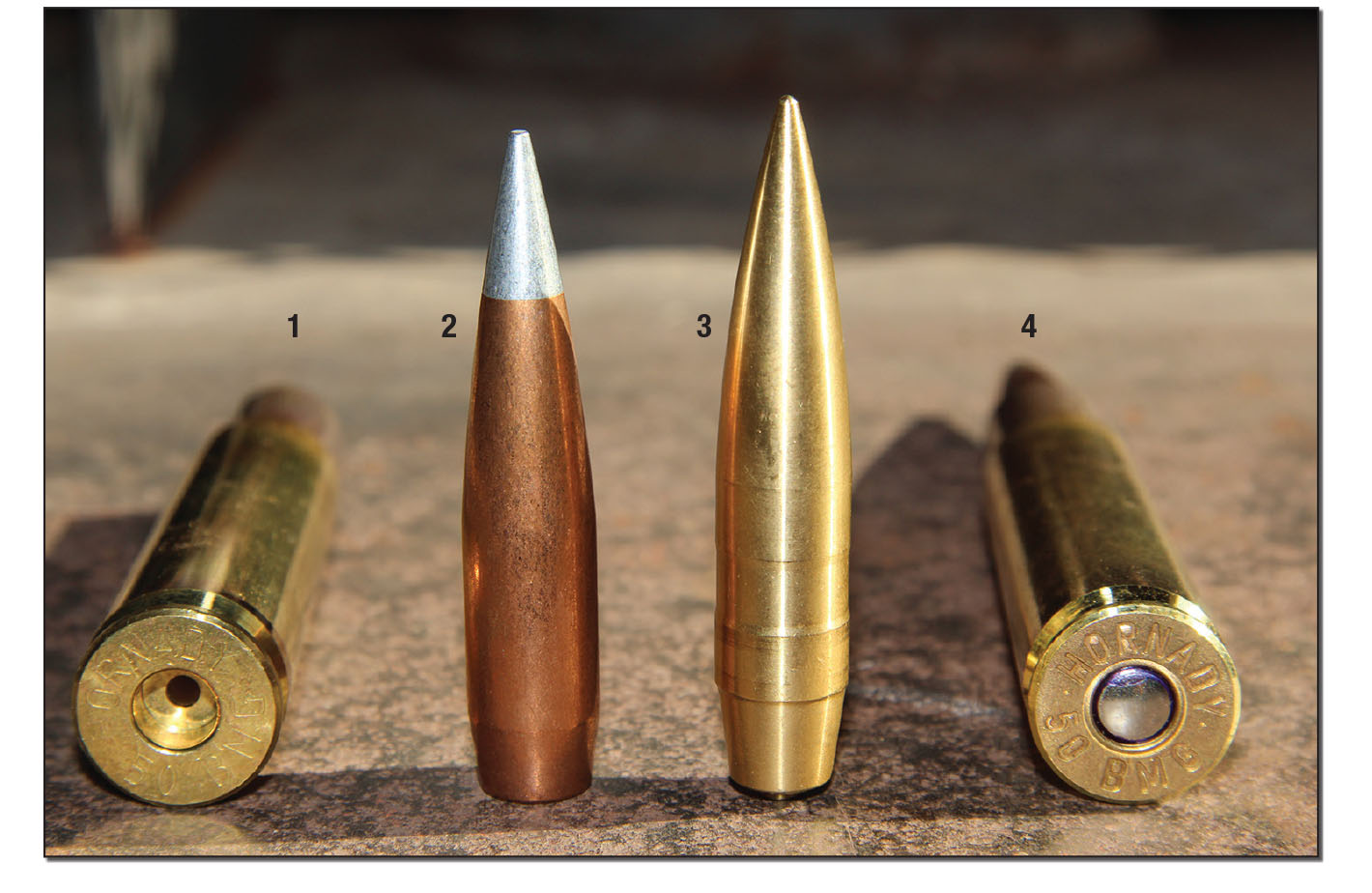
Brass, bullets and ammunition used for testing included the: (1) Hornady Match brass (used for handloads), (2) Hornady’s 750-grain A-MAX, (3) Lapua’s 800-grain Bullex-N and (4) Hornady 750-grain A-MAX ammunition.
The genius of John Browning brought the .50 BMG into the world, building first the cartridge and then the machine gun to run it through. The idea was hatched during World War I as an anti-aircraft and armor-piercing round, essentially modeled on a scaled-up .30-06 Springfield. The round was eventually adopted by the military as the M1921 Browning machinegun, which by World War II, had transformed into M2 Browning Machine Guns, its multi-generational upgrades are still in use today.
It took until the 1980s for the .50 BMG to make its way into conventional shoulder-fired rifles, one of the first Barrett’s M82. This allowed skilled military snipers to eliminate targets (soldiers or equipment) at more than a mile (1,760 yards), making it more difficult for enemies to pinpoint shooters’ positions. The .50-caliber’s ultra-high BC is an extreme-range natural, resulting in high-energy/velocity retention and minimized wind drift at incredible ranges.
The average .50 BMG case holds 290 grains of water, case walls including a long taper to assure smooth feeding and extraction in various automatic weapons. Rifling twist for this cartridge is typically 1:15 with eight lands and grooves. The .50 uses a specialized primer measuring .317 inch across, in contrast to the .210 inch of a standard large rifle primer. Most U.S. and NATO brass is Boxer primed, though keep in mind if using reclaimed military brass, that other countries often employ Berdan primers. Average chamber pressure (according to U.S. Army Ammunition Data Sheets) is 54,923 psi, with proof/test pressure listed as 65,000 psi.
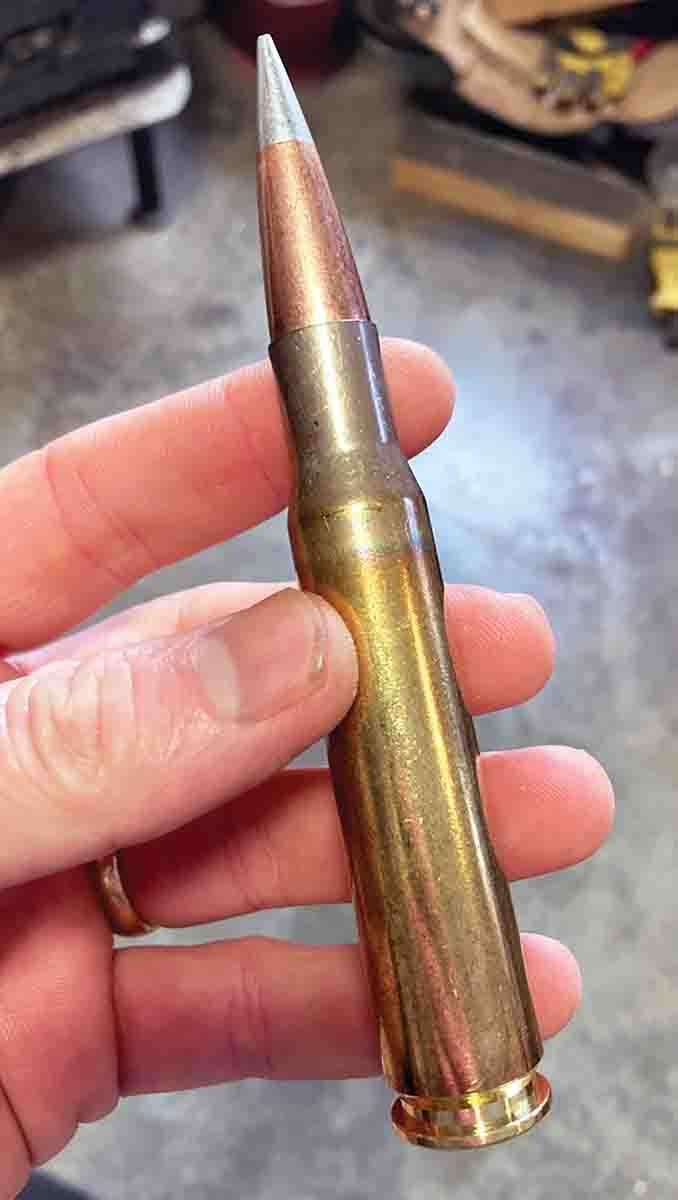
The .50 BMG sends a 750-grain bullet at up to 2,750 fps, burning 200- to 260-grains of slow-burning powder to do so. The round is quite expensive to shoot, as both rifles and components are pricey.
An unfired .50 BMG bullet measures .510 inch in diameter, technically more than the .50 inch/12.7mm maximum allowed for nonsporting Title I firearms under the U.S. National Firearms Act. The .50 BMG barrels measure only .50 inch or 12.7mm across the lands, with slightly larger grooves. The oversized bullets “swag” into the grooves upon firing, forming a tight seal while engaging the rifling.
Being the most powerful commonly available cartridge not considered a destructive device under the National Firearms Act, the .50 is a common subject of political controversy (only one of the reasons Barrett offers their proprietary .416 Barrett). A 1999 Office of Special Investigations briefing could not identify a single instance in which a .50 BMG rifle was used in a murder, though ownership remains illegal or highly restricted in Washington, D.C. (they won’t allow registration of .50 BMG rifles, thus rendering civilian possession unlawful), California (.50 BMG rifles registered prior to enacted bans remain lawful), Connecticut (Barrett M82A1 .50 BMG rifle specifically), while Maryland imposes additional sale/transfer regulations. Representative Sheila Jackson Lee (D-TX) was recently pushing legislation that, among other things, would make the .50 BMG illegal on a national level. In the current political climate, there are likely more restrictions being discussed. United Kingdom residents may own a .50 only after completing standard centerfire rifle paperwork, and proving to the bureaucrats involved they have a legitimate need for one. Canadian residents are subject to a May 1, 2020, ban on various “military-style” firearms, thanks to Prime Minister Justin Trudeau and company. These weapons, including any .50 BMGs, were supposed to have been surrendered two years after the ban.
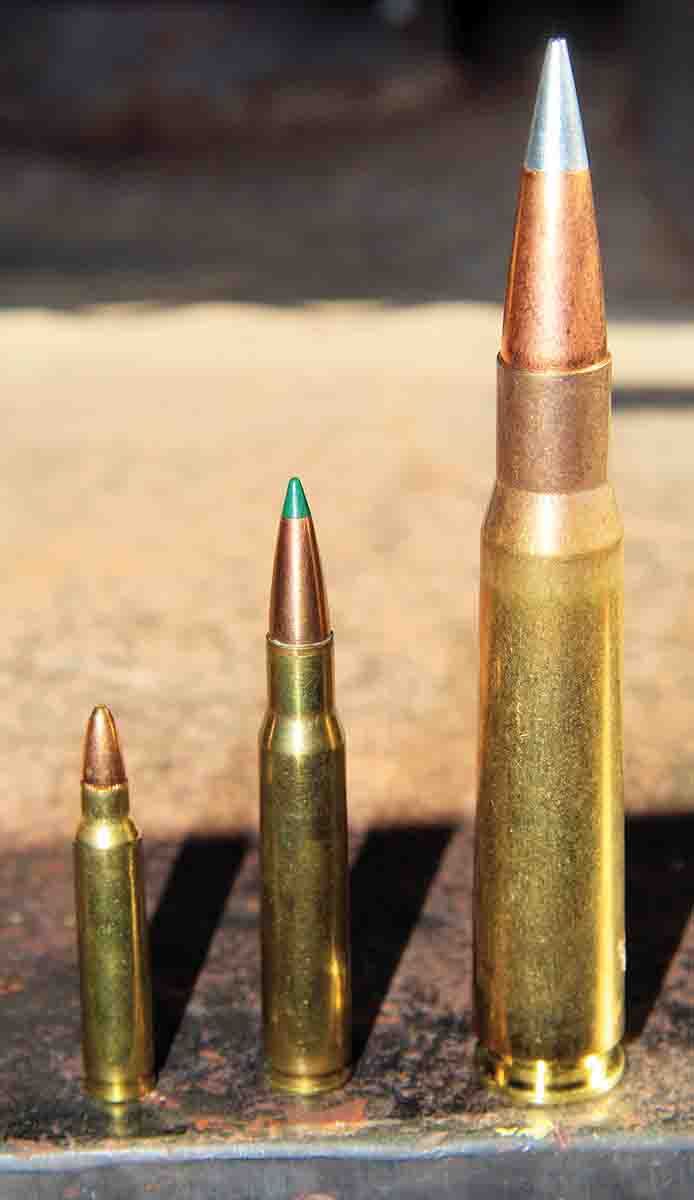
Shown here for comparison are three famous military cartridges (left to right): the 5.56x45mm NATO (.223 Remington), .30-06 Springfield and the .50 BMG (Browning Machine Gun).
The .50 BMG was used as a sniper round as early as the Korean War. Legendary U.S. Marine sniper Carlos Hathcock’s former confirmed long- distance record kill (2,090 meters) was made using a M2 Browning Machine Gun equipped with a telescopic sight in 1967. That record stood until 2002, when Canadian Army Corporal Rob Furlong of the PPCLI zapped a Taliban combatant in Afghanistan at 2,430 meters. In 2017, an unnamed Canadian Joint Task Force 2 sniper used a McMillan Tac-50 to kill an Islamic State insurgent in Iraq at 3,540 meters – today’s longest confirmed military sniper kill.
As a highly specialized cartridge, the .50 BMG also requires very specialized bullets, powders and tools. Regarding bullets and powders, limited options are offered, particularly in these strange times and the hobby hoarding that it has spawned. In bullets, listed lightest to heaviest, options include Barnes’ 647-grain TAC-X and TSX, military surplus 650-grain M-33, 655-grain ADI full metal jacket, 750-grain Hornady A-MAX, Barnes Banded Solids and TAC-LR, plus 800-grain Barnes Banded Solid and the discontinued Lapua Bullex-N. A comprehensive list of .50 BMG powders would include Hodgdon’s H-50BMG and US-869, Alliant’s Reloder 50, Vihtavuori’s 24M41 and 20N29 and Shooters World SW- 50BMG. There are a few others, but these are the most widespread and popular. As a less than mainstream cartridge, .50 BMG components are generally manufactured in infrequent and/or limited runs.
The .50 BMG requires a specialized press, large enough to handle the added leverage needed to resize the huge and thick-skinned cases, and accept 1¼-inch dies used for the voluminous brass. For that task, I waited nearly a year to receive a Hornady Lock-N-Load 50 BMG Press Kit, including the specialized press, primer seater and dies needed to assemble all loads listed here. Charges of 195 to 265 grains of powder are standard for fueling the .50 BMG, meaning I will get only 25 to 35 rounds out of every pound of powder, a far cry from the 280 .223 Remington rounds or 140 .30-06 rounds I would generally load from a pound of powder. Bullets will run about $2 to $2.50 per trigger pull. Owning and shooting a .50 BMG is obviously a pricey proposition.
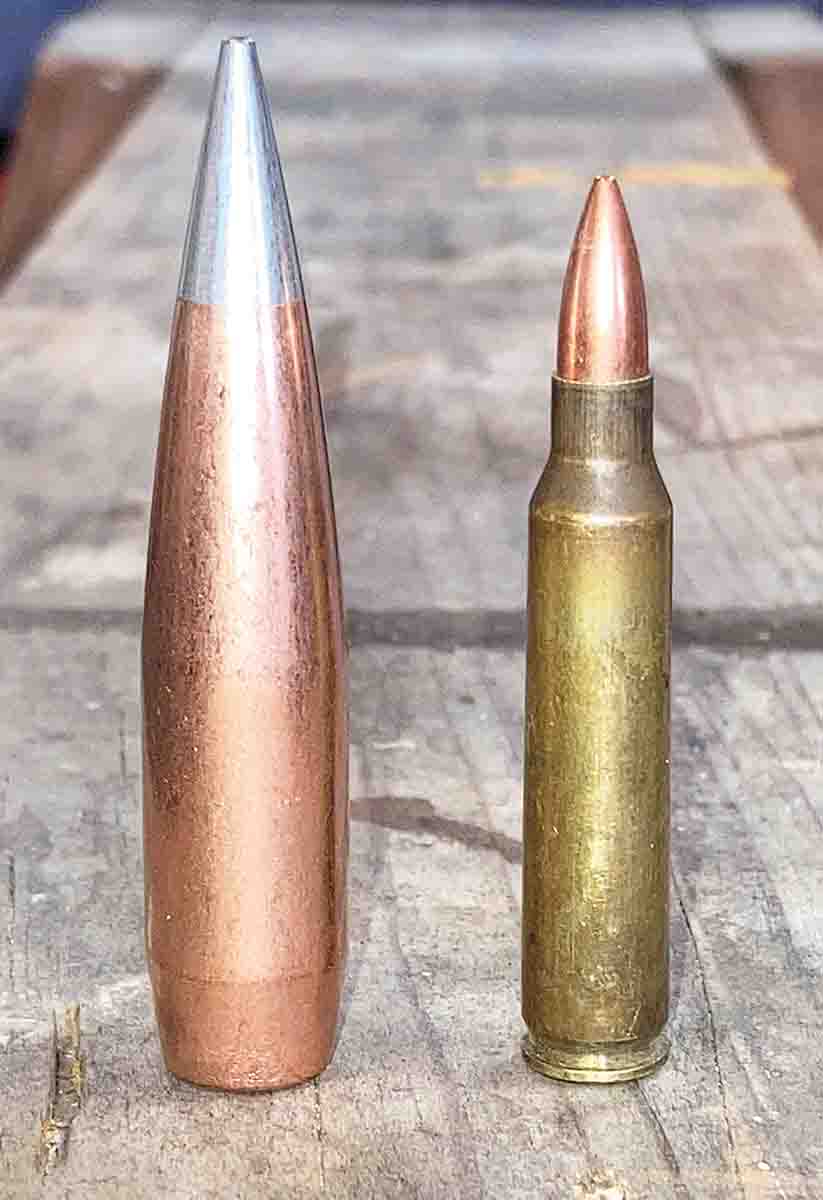
Hornady’s 50-caliber, 750-grain A-MAX (left) – with its 1.05 G1 ballistic coefficient – is a lot of bullet. A fully-loaded 5.56mm/.223 Remington cartridge (right) would neatly fit inside of a hollowed-out .50 BMG bullet.
Securing fodder for this test required some serious scrounging, starting in the middle of an ammunition and component drought and lasting nearly a year. Powder, quite surprisingly, proved the easiest part of the equation. Hodgdon, Shooters World and Vihtavuori came through with their 50-caliber contributions, Alliant’s Reloder 50 was found on a local store shelf. Bullets and brass were more problematic. I was able to secure a very limited supply of Hornady 750-grain A-MAX and Lapua 800-grain Bullex-N (since discontinued), so loads would by necessity revolve around just two bullets, each paired with only two charge weights per powder. Though, having six compatible powders on hand produced a respectable showing. Hornady supplied all the match grade cases I needed, but it took time. CCI’s plain-boxed No. 35 primers were used in all loads.
The OD green test rifle, on loan from Jim O’Connell of GunPeck in Peck, Idaho, was a recoil operated semiautomatic Barrett M107A1, an older military-grade model with all-steel construction. Barrett, as discussed, provided the first shoulder-fired semiautomatic .50BMG rifles. The rifle included a 29-inch fluted barrel with 1:15 rifling twist and holding a Model 82A1 Muzzle Brake, which looks like something that would come off a tank barrel. This is a lot of rifle, measuring 57 inches in length and weighing 32.7 pounds stripped. The detachable box magazine holds 10 rounds and the 23-inch Picatinny rail includes a 27-MOA pitch and flip-up iron sights – though the rifle was tested with an optic. The rear includes a handgrip that accepts an adjustable monopod to steady the butt, an adjustable steel bipod located up front and quickly detached via a spring-loaded/ball-lock steel pin. The rifle is assembled and held together by similar pins, a shorter one going through a receiver and the frame up front, a longer one behind the comb and in front of the buttpad. The rifle’s weight and recoil-operated system makes the rifle quite manageable, more of a slow but robust shove rather than a sharp punch. The M107A1 was topped by a Nightforce ATACR 7-35x 56mm F1 scope set in Trijicon’s rugged 34mm Quick Release Flattop Mount base/rings.
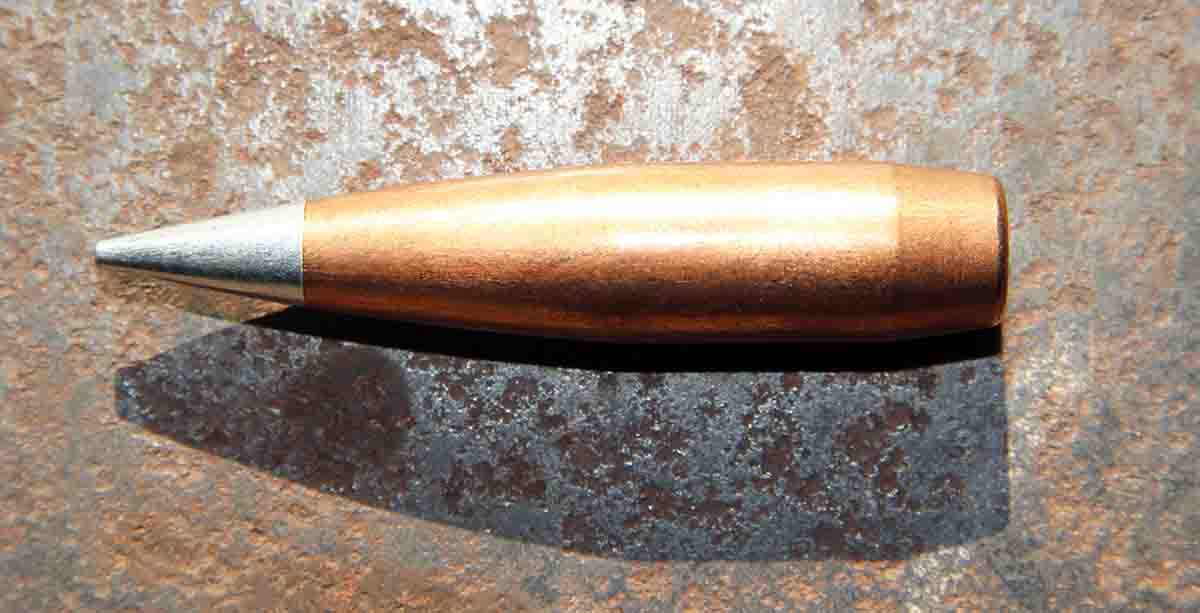
Of the two .50-caliber bullets tested, Laupa’s Bullex-N represented the 800- grain weight class. It is a turned-brass solid with a ballistic coefficient of .98.
Loads consisted of Hornady’s 750-grain A-MAX and Lapua’s 800- grain Bullex-N, as mentioned, each paired with Hodgdon US-869 (210- and 230-grain charges with Hornady bullets, 210- and 230-grain charges Lapua bullets) and H-50BMG (190- and 210-grain charges with the Hornady bullets, 205- and 225-grain charges with the Lapua bullet); Alliant Reloder 50 (210- and 230-grain charges with Hornady bullets, 210- and 225-grain powder charges with the Lapua bullet); Shooters World SW-50BMG (200- and 215-grain charges with Hornady bullets, 185 and 195 Lapua bullets); Vihtavuori 24N41 (200.5- and 215-grain charge weights for the Hornady bullet, 200.5- and 210.5-grains of powder with the Lapua bullet) and 20N29 (225- and 240-grain charge weights with the Hornady bullet, 230- and 240-grain charge weights with the Lapua bullet). The wide disparity of published maximum loads using the same bullets and powders prompted me to keep things on the conservative side. Even the heavier listed loads are well below maximum. All listed loads were seated to an overall loaded length of 5.73 inches.
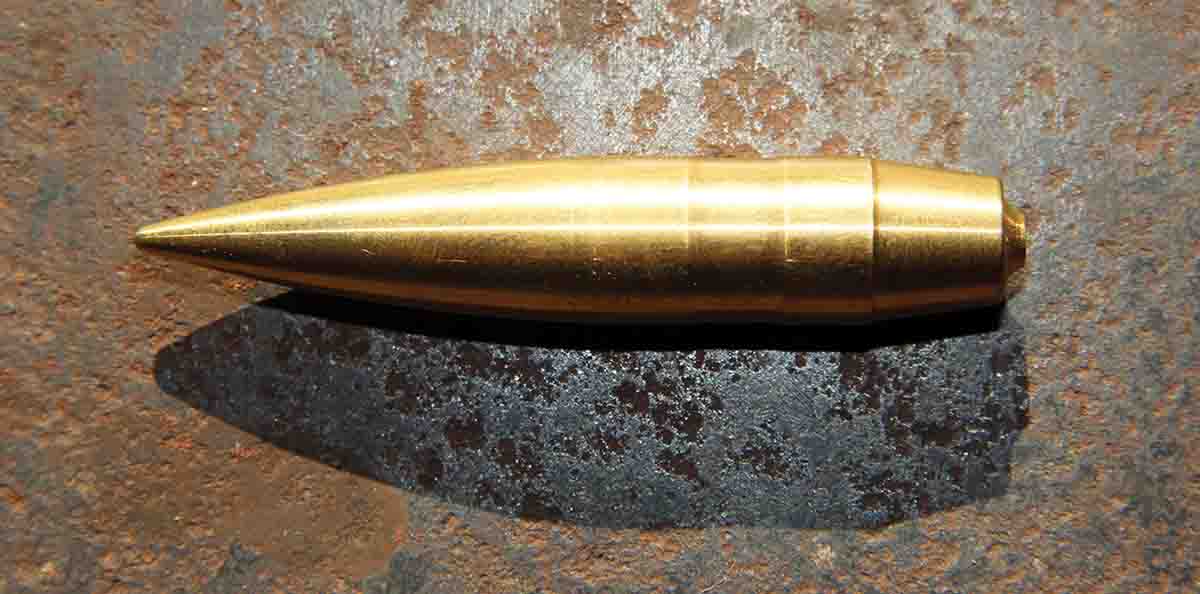
Due to current component shortages, Patrick was only able to secure two .50 BMG bullets for testing. Hornady’s 750-grain A-MAX is one of the best, including an astounding 1.05 ballistic coefficient.
I did not have as much fun shooting the .50 BMG as I had envisioned. When shooting begins, it offers some obvious thrills, like a rollercoaster, but after the first 10 to 15 rounds are fired, that thrill wears thin and is quickly replaced by the drudgery of shooting such a brutal rifle. Recoil is quite manageable, as mentioned, though its cumulative effects certainly begin to take their toll. The larger challenge is dealing with the .50’s considerable muzzle blast – the kind of muzzle blast that creates clouds of dust and spinning debris.
I wore expensive SureFire EP3 Sonic Defenders gel plugs covered by bulky Venturegear VG80 Series earmuffs during all testing. Still, after 15 to 20 shots I would begin developing a raging migraine. The test rifle’s barrel also turned branding hot after only three to six shots, and cooled quite slowly in the high-90-degree heat that dominated the test period. Testing, therefore, proceeded at glacial speed, conducted over a series of days during a two-week period in the interests of avoiding flinching and opening groups. Shooting the .50 BMG well requires special training – or at least a lot of familiarization.
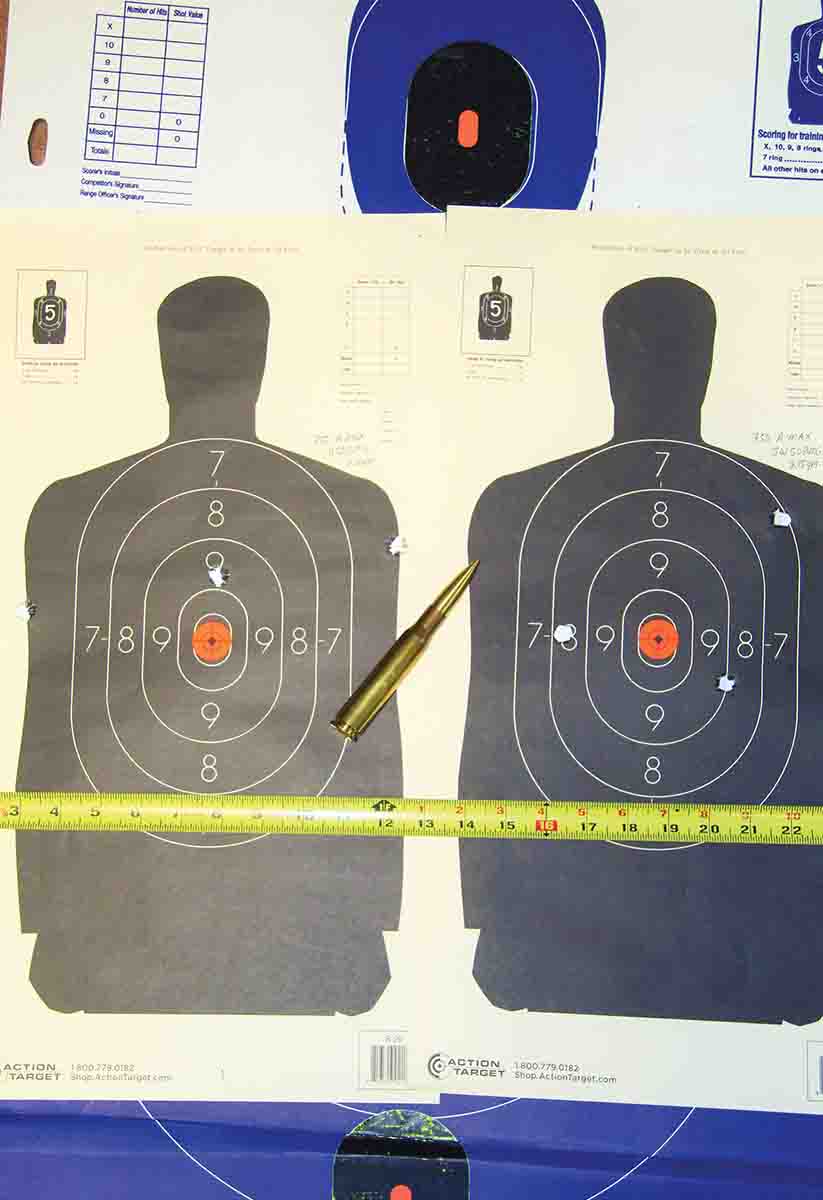
These are fair representatives of the three-shot groups produced by the Barrett M107A1 at 500 yards. The left group measures around 6.25 inches – the best produced in this test – using Hornady’s A-MAX and Shooters World SW-50BMG powder.
I’ll fully admit – and my lack of experience with the powerful rifle may very well have factored – I wasn’t overly impressed with the accuracy of the Barrett, or its rough trigger. I don’t know what I expected, really, and all groups were shot at 500 yards, but… the best groups measured 6¼- to 7-inches center-to-center, with the worst – just a couple, really – measuring nearly a foot across. Also, even with a generous 11.5-by-22.5-inch B-27 silhouette target (meant for pistol shooting at 50 feet), groups often wandered onto the neighboring target face between various bullets and loads. A .50 BMG owner would really need to find a compatible load, zero the rifle with it and stick with it religiously (easier said than done when powder is so difficult to secure and your rifle shoots a pound every 25 shots).
All powders chosen had their moments, so choosing a definitive winner would be impossible. One thing that was apparent is this rifle preferred velocity, every one of the tightest groups assembled resulted from the heavier load of the ladder pair. The single exception might be the Hornady 750-grain A-Tip using 210 grains of Hodgdon H-50BMG at 2,433 fps, which produced a 6.5-inch group. Shooters World SW-50BMG generally created the smallest groups, driving my velocity/accuracy theory by also turning in some of the high-est velocities. Even though some of the listed loads represented official start loads, all cycled without a hitch.
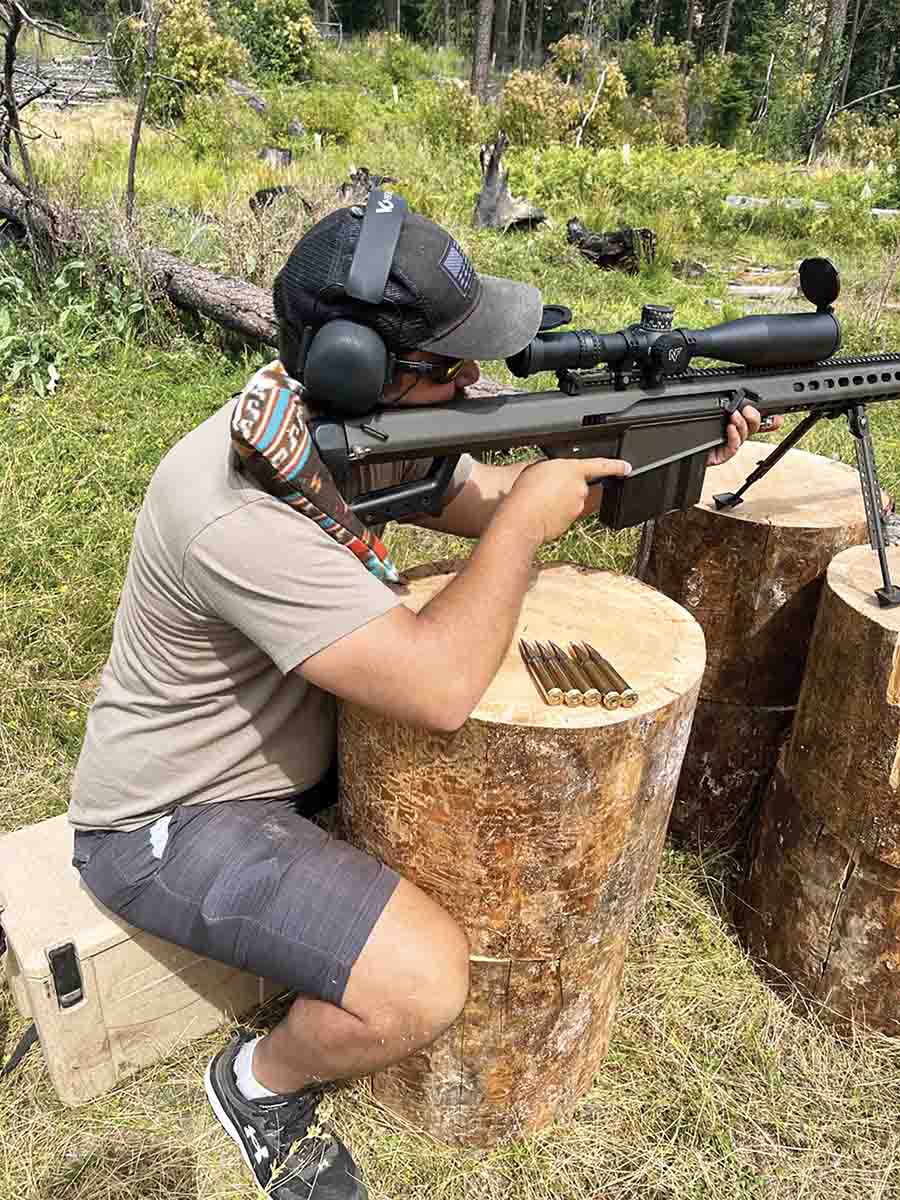
Shooting the .50 BMG offers a couple of surprises. The first, recoil proved quite manageable through the rifle’s weight, large muzzle brake and recoil operation. The second is the tremendous noise produced.
This project proved a unique and enlightening experience, but it has not inspired me to run out and seek a .50 BMG of my own. Quite the opposite, really. I am not man nor rich enough to own the big .50. I’ll just stick to my mild-mannered varmint rifles, thank you very much!









.jpg)


